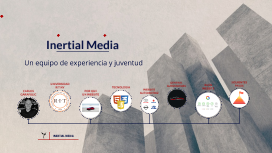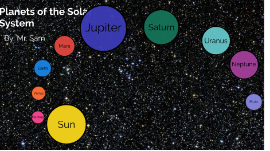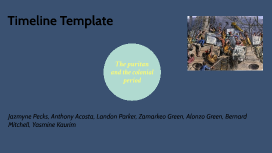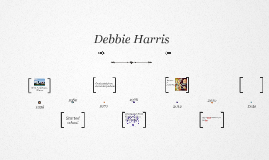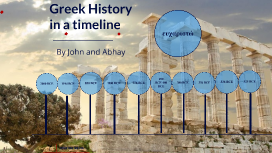Timeline template
Transcript: Greek History in a timeline By John and Abhay INERTIAL MEDIA 2000 BCE - First settlers were the Myceneans - 1650 B.C.E., the Minoans occupied the island of Crete, south of the Greek mainland. - The Mycenaeans were from India through the middle east and into Greece in 2000 B.C.E. 2000 BCE Mycenean Gate A.K.A Lion's gate. Opened 1250 BCE. Mycenean Gate Mycenean People Historians believe they were located in Crete. Historians believe Mycenaeans are Polytheistic and syncretistic. Religious syncretism exhibits the blending of two or more religious beliefs into a new system on which the Mycenaeans dwell. They would also add gods from cultures they traded with -- including the Egyptians and Phoenicians. Their belief included sacrifices of people to Gods. 1600 BCE Trojan War 1194 BCE- 1184 BCE 1194 BCE This was the war between the Greeks and the people of Troy The fight is due to Paris abducting Helen, the wife of Menelaus of Sparta. Menelaus then persuades Agamemnon to lead an army against the Trojans. Apollo, Artemis, Ares, and Aphrodite sided with the Trojans, while Hera, Athena, Poseidon, Hermes, and Hephaestus aided the Greeks. Battle of Troy Movie Clip https://www.youtube.com/watch?v=Td1uPq9K--E Troy WOLD HERITAGE TURKEY. Trojan Horse TROJAN HORSE Greek Alphabet 850 BCE The early Greek alphabet was based on the Semitic alphabet of the Phoenicians. It was created approximately 850 BCE. Greek Alphabet Alphabet Golden Date 776 BCE 776 BCE The first Olympic games began in 776 BCE. The Olympic games were religious festivals to honour Zeus. The games were held in Olympia. Koroibos, a cook from the nearby city of Elis, won the stadion race, a foot race 600 feet long. Olympic stadion ground Ground Homer 800 BCE Homer is a renowned Greek author of the Iliad and the Odyssey. These two writings were hugely influential in Greek and Western mindsets. These stories are believed to be the first epics, and it is essential because it explains life in early Greece. The Odyssey The Odyssey was composed around the year 700 B.C.E. The power of telling our stories is what "The Odyssey" demonstrates. Knowing that our past suffering is behind us brings us joy, but it also helps us to see how we fit into the larger scheme of things. Other individuals being aware of our experiences helps us feel like we belong. Odyssey Iliad Iliad The Iliad explains the story of the Greek struggle to rescue Helen, a Greek queen, from the Trojans. It offers several moral lessons to its readers, including the importance of leaders treating their soldiers with respect, the importance of accepting apologies, and the need for respecting family bonds. The famous Iliad was assumably written in 762 B.C. Persian War 1st and 2nd 490 BCE-480 BCE The battle of Marathon started 499 BCE and lasted until 449 BCE. The Persian king Darius ordered the invasion to punish the city-states of Athens and Eretria because the Ionic greeks started rebelling against the Tyrants who Persia installed in Greece. Athens succesfully win the battle. Analysis The Persians had about 90,000 men compared to the Greeks having 20,000 Statistics Strategy By the Greeks The Greek and Athenian army had been assembled rapidly, but Miltiades, its general, was a wise and capable leader. By purposefully weakening the center of his battle line, Miltiades duped the Persians. The Persians were attacked from the sides causing confusion. The Persians were swiftly routed, losing just about 6400 soldiers as opposed to the Greeks' 192 men. Persian 2nd war- 480 BCE 2nd war This time the persians fought against the Greeks with Xerxes 1, king of Persia. The Persians lose their battle again fair and square against the Greek army. The tale of the messenger Pheidippides running 25 miles to Athens to deliver the news of the Persian defeat inspired the creation of the modern marathon. Impact on Greek art Impact The war with Persia had a great impact on the ancient Greeks. The Athenian Acropolis was destroyed by the Persians, but the Athenian response was to build a beautiful building. Its remains can still be seen today. Greek art has many depictions of Greeks fighting Persians, and Greek works also depict Persian enemies. The war also brought a show of unity among the Greeks that was essential to their success in defeating their enemies. Plato 380 BCE Plato was a Greek philosopher born in Athens during the Classical period in Ancient Greece. He founded the Platonist school of thought and the Academy, the first institution of higher learning on the European continent. Majority of Plato’s works are in the form of dialogues. He wrote Laches about courage, Lysis about friendship, and Charmides, which talks about common sense, these are but a few. Altogether, his dialogues basically formed what his philosophical teachings would be when he got to his Academy. Death Plato's View on death Plato introduced the idea of incarnation and immortal souls. Plato alleged that souls that were good and full of knowledge could gain






